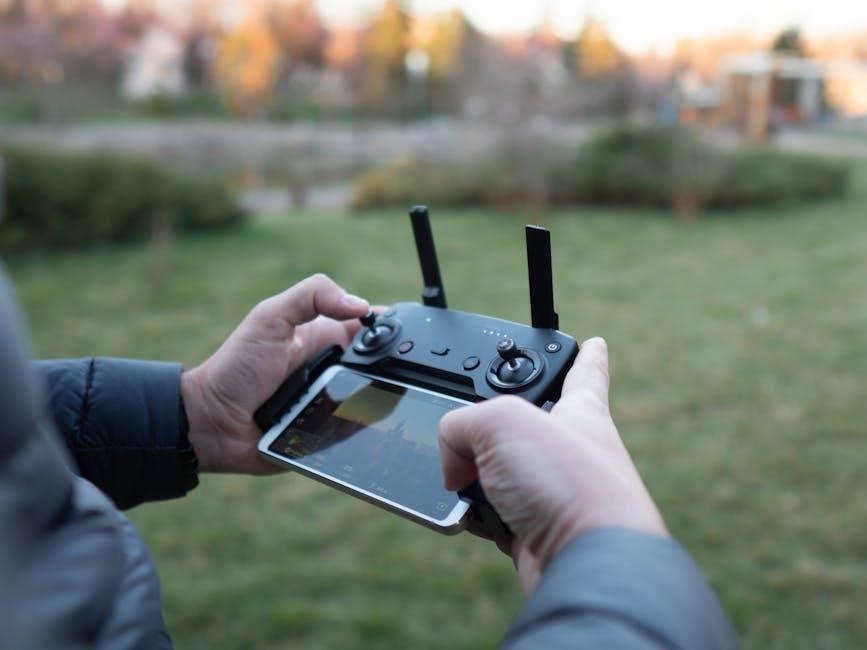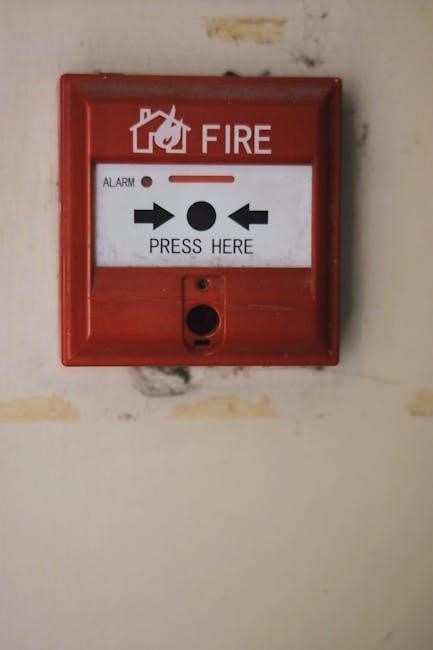The Nighthawk Carbon Monoxide Alarm is a vital component of your home safety system‚ designed to detect dangerous CO levels and protect your family from potential threats.
1.1 Importance of Carbon Monoxide Detection
Carbon monoxide (CO) is a silent‚ odorless‚ and colorless gas that can be deadly in high concentrations. It inhibits the blood’s ability to carry oxygen‚ leading to severe health risks‚ including brain damage‚ heart problems‚ and even death. Early detection is critical‚ as CO poisoning often goes unnoticed until symptoms appear. The U.S. Consumer Product Safety Commission recommends installing at least one CO alarm in every home to protect families from this invisible threat. A reliable CO alarm like the Nighthawk model ensures early warning‚ providing precious time to evacuate and seek safety.
1.2 Overview of the Nighthawk CO Alarm
The Nighthawk Carbon Monoxide (CO) Alarm is a reliable‚ user-friendly device designed to protect families from the dangers of CO poisoning. It features a digital display showing real-time CO levels‚ peak level memory to track the highest concentration detected‚ and a test/reset button for quick functionality checks. The alarm is powered by a 9V battery with optional AC plug-in models available‚ ensuring continuous monitoring. Its sleek design and easy installation make it a practical addition to any home safety system‚ providing peace of mind with its advanced detection capabilities.
1.3 Key Features of the Nighthawk Model
The Nighthawk CO Alarm boasts a digital display showing real-time CO levels‚ peak level memory to track the highest concentration detected‚ and a test/reset button for quick checks. It features battery backup for continuous monitoring during power outages and optional AC plug-in models. The alarm is designed for residential use‚ providing early detection of CO threats. Its compact design and easy installation make it a practical solution for home safety‚ ensuring protection against the silent danger of carbon monoxide with reliable performance and user-friendly functionality.
Understanding Carbon Monoxide (CO)
Carbon monoxide (CO) is a colorless‚ odorless gas produced by burning fuels like gasoline‚ wood‚ and natural gas. It prevents blood from carrying oxygen‚ posing severe health risks or death. Early detection is critical‚ making CO alarms like the Nighthawk essential for home safety and protection against this invisible threat.
2.1 What is Carbon Monoxide?
Carbon monoxide (CO) is a colorless‚ odorless‚ and tasteless gas produced by incomplete combustion of fuels like gasoline‚ wood‚ natural gas‚ or propane. It is invisible and non-irritating‚ making it difficult to detect without a sensor. CO interferes with oxygen transport in the blood‚ leading to tissue damage or death in high concentrations. Common sources include faulty heating systems‚ idling vehicles‚ and malfunctioning appliances. Early detection is critical‚ as CO exposure can cause severe health issues or be fatal‚ even at low levels over extended periods. Understanding CO is essential for ensuring home safety and preventing tragedies.
2.2 Sources of Carbon Monoxide in the Home
Carbon monoxide in homes primarily comes from fuel-burning appliances like furnaces‚ water heaters‚ and stoves. Malfunctioning or improperly vented devices‚ such as cracked heat exchangers in furnaces or blocked chimneys‚ can release CO. Other sources include idling cars in attached garages‚ portable generators‚ and fireplaces without proper ventilation. Even everyday activities‚ like cooking on a gas stove or using a space heater‚ can generate CO if not monitored. Identifying these sources is crucial for preventing CO buildup and ensuring a safe living environment.
2.3 Health Risks Associated with CO Exposure
Carbon monoxide exposure poses serious health risks by interfering with oxygen transport in the blood. It binds to hemoglobin‚ forming carboxyhemoglobin‚ which reduces oxygen delivery to vital organs. Symptoms of CO poisoning include headache‚ dizziness‚ nausea‚ and fatigue‚ often mistaken for flu. Prolonged exposure can lead to confusion‚ loss of consciousness‚ and even death. High levels of CO can cause irreversible brain‚ heart‚ and organ damage. The risk is greater for vulnerable populations‚ such as children‚ pregnant women‚ and individuals with pre-existing medical conditions. Awareness and prevention are critical to avoiding these life-threatening consequences.

Features and Benefits of the Nighthawk CO Alarm
The Nighthawk CO Alarm offers a digital display‚ peak level memory‚ battery backup‚ and a test/reset button‚ ensuring reliable protection and peace of mind.
3.1 Digital Display for CO Levels
The Nighthawk CO Alarm features a digital display that continuously monitors and shows carbon monoxide levels in parts per million (ppm). This real-time data helps users assess the severity of a potential threat immediately. The display updates constantly‚ ensuring accurate readings. In case of elevated CO levels‚ the alarm sounds‚ and the display highlights the danger. This feature is crucial for quick decision-making‚ allowing you to take action to protect yourself and your family. The clear‚ easy-to-read screen provides peace of mind‚ knowing your home is continuously monitored for CO risks.
3.2 Peak Level Memory Function
The Nighthawk CO Alarm includes a Peak Level Memory function‚ which records the highest carbon monoxide concentration detected since the last reset. This feature is invaluable for identifying potential CO spikes‚ even if levels return to normal. It provides a clear record of CO incidents‚ helping users and emergency responders assess the severity of exposure. The memory function ensures no dangerous CO event goes unnoticed‚ offering critical data for safety assessments and necessary actions to prevent future hazards. This feature enhances the alarm’s effectiveness in safeguarding your home environment.
3.3 Battery Backup and Power Options
The Nighthawk CO Alarm offers reliable power options‚ including an AC plug-in connection and a 9V battery backup. This ensures continuous monitoring even during power outages. The battery backup provides peace of mind‚ maintaining protection when electricity is lost. The alarm is designed to operate seamlessly with either power source‚ ensuring uninterrupted detection of carbon monoxide. The 9V battery is easy to install and replace‚ making maintenance straightforward. This dual-power capability enhances safety and reliability‚ keeping your home protected at all times.
3.4 Test/Reset Button Functionality
The Test/Reset button allows you to check the alarm’s functionality and silence it during false alarms. Pressing the button tests the electronic circuitry and ensures the alarm is working correctly. It also temporarily mutes the alarm sound when activated. The LED indicator will flash to confirm the test was successful. Regular testing is recommended to ensure the alarm remains operational and ready to detect carbon monoxide levels. This feature provides reassurance that your safety device is functioning properly at all times.

Installation Guidelines
Proper installation is crucial for the Nighthawk CO Alarm’s effectiveness. Choose a location near bedrooms‚ avoid basements‚ and follow the step-by-step guide for accurate setup and optimal protection.
4.1 Choosing the Right Location for the Alarm
Proper placement of the Nighthawk CO Alarm is essential for accurate detection and effectiveness. Install the alarm on every level of your home‚ especially near sleeping areas‚ to ensure early detection. Avoid locations near fuel-burning appliances‚ such as furnaces or water heaters‚ as they may cause false alarms. The alarm should be at least 5 feet away from cooking appliances and not installed in garages‚ basements‚ or areas prone to moisture. Choose a central location to maximize coverage and ensure your family’s safety.
4.2 Step-by-Step Installation Instructions
Mount the Nighthawk CO Alarm on a wall or place it on a shelf. Avoid basements‚ garages‚ or areas near fuel-burning appliances. Use the provided screws to secure the mounting bracket to the wall‚ ensuring the alarm is at least 5 feet away from cooking appliances. Insert the battery or connect to AC power as specified. Test the alarm by pressing the Test/Reset button to ensure it functions properly. Refer to the manual for specific installation requirements and safety guidelines to maximize protection.
4.3 Post-Installation Checks and Tests
After installation‚ press the Test/Reset button to ensure the alarm sounds and the green LED flashes. Verify the alarm is functioning correctly by checking the digital display for any CO levels. Perform a weekly test to confirm proper operation. Ensure no obstructions block the sensor inlet and that the alarm is free from dust or debris. Refer to the user manual for additional testing procedures to ensure your Nighthawk CO Alarm is working effectively and providing reliable protection for your home.

Testing and Maintenance
Test the Nighthawk CO Alarm weekly using the Test/Reset button to ensure proper function. Check the digital display for CO levels and clean the sensor regularly to maintain accuracy. Refer to the user manual for detailed maintenance instructions to keep your alarm reliable and effective in protecting your home from carbon monoxide threats.
5.1 How to Test the CO Alarm
To test the Nighthawk CO Alarm‚ locate the Test/Reset button on the front of the unit. Press and hold the button until the alarm sounds and the green LED flashes. This verifies the alarm’s electronic circuitry is functioning correctly. Release the button to stop the test. Ensure the alarm emits a loud‚ clear sound at 85 decibels to confirm it is working properly. Regular testing ensures the sensor and battery (if applicable) are operational. Refer to the user manual for additional guidance on testing and maintaining your CO alarm effectively.
5.2 Regular Maintenance Tips
Regular maintenance ensures your Nighthawk CO Alarm functions optimally. Check the battery monthly and replace it annually or as indicated by the low-battery warning. Use a soft brush to gently clean the alarm’s exterior and sensor openings to remove dust or debris. Avoid exposing the alarm to contaminants like paint fumes or cleaning agents. Test the alarm weekly and ensure it is securely mounted in the recommended location. Refer to the user manual for specific maintenance schedules and guidelines to maintain peak performance and reliability of your CO alarm.
5.3 When to Replace the Alarm
Replace the Nighthawk CO Alarm every 10 years or as specified by the manufacturer. If the alarm shows signs of physical damage‚ emits intermittent beeps without CO presence‚ or fails to respond during testing‚ it should be replaced immediately. Additionally‚ if the unit’s digital display is malfunctioning or the battery compartment is corroded‚ replacement is necessary. Always adhere to the warranty period and follow the user manual’s guidelines for replacement to ensure continuous protection and reliability of your CO detection system.

Troubleshooting Common Issues
Address common issues like error beeps‚ false alarms‚ or connectivity problems by consulting the user manual. Resetting the alarm or replacing batteries often resolves these issues quickly.
6.1 Understanding Error Codes and Beeps
The Nighthawk CO alarm uses specific beeps and error codes to indicate issues. Three beeps signal CO detection‚ while one beep may indicate a low battery or malfunction. Refer to the user manual for a detailed guide on error codes‚ such as “ERR” or “LOB‚” which often point to sensor or battery problems. Understanding these codes helps resolve issues quickly‚ ensuring your alarm functions properly and maintains your home’s safety. Always consult the manual for troubleshooting steps before contacting support.
6.2 Resolving False Alarms
False alarms on your Nighthawk CO alarm can occur due to cooking fumes‚ vehicle exhaust‚ or high humidity. To resolve this‚ press the Test/Reset button to silence the alarm and assess the situation. Ensure the alarm is not placed near potential CO sources like stoves or garages. If the alarm persists‚ move it to a different location or check for sensor obstructions. Regular cleaning and maintenance can also prevent false alarms. Always verify the environment before assuming a false alarm‚ and refer to the manual for additional troubleshooting steps.
6.3 Fixing Connectivity or Power Issues
If your Nighthawk CO alarm experiences connectivity or power issues‚ first ensure it is properly plugged into a working outlet. For battery-only models‚ install fresh batteries and check the expiration date. If hardwired‚ verify the circuit breaker or fuse. Clean the alarm to remove dust or debris that may interfere with operation. Press the Test/Reset button to reset the alarm and ensure it functions correctly. If issues persist‚ refer to the user manual or contact customer support for assistance.
Emergency Procedures
If the Nighthawk CO alarm sounds‚ immediately evacuate the premises‚ open windows for ventilation‚ and avoid using elevators. Contact emergency services promptly and stay outside until it is safe to re-enter.
7.1 What to Do When the Alarm Sounds
If the Nighthawk CO alarm activates‚ stay calm and act quickly. Immediately evacuate all household members‚ including pets‚ and move to fresh air outside. Do not use elevators. Open windows and doors to ventilate the area but avoid re-entering the premises until authorities confirm it is safe. Contact emergency services or your local fire department to report the incident. After evacuation‚ check for potential CO sources and ensure the alarm is silenced only by trained professionals. Never ignore the alarm or attempt to investigate the cause yourself.
7.2 Evacuation and Safety Measures
When evacuating due to a CO alarm‚ move quickly to fresh air outdoors. Avoid using elevators and gather at a pre-designated safe meeting point. Ensure all household members‚ including pets‚ are accounted for. Do not re-enter the building until authorities confirm it is safe. If anyone experiences symptoms like dizziness or nausea‚ seek medical attention immediately. Stay away from windows and doors to prevent potential CO re-entry. Always prioritize your family’s safety and follow emergency protocols outlined in your safety plan.
7.3 Contacting Emergency Services
If your Nighthawk CO alarm sounds‚ immediately call 911 or your local emergency number from a safe location. Provide your address and any relevant details about the situation. Stay on the line until help arrives. Do not re-enter your home until emergency services confirm the area is safe. If anyone is experiencing CO poisoning symptoms‚ such as dizziness or nausea‚ inform the dispatcher for priority medical assistance. Remember‚ prompt action is crucial to ensure everyone’s safety.

Warranty and Support Information
The Nighthawk CO alarm is backed by a 10-year limited warranty. For assistance‚ contact Kidde’s Consumer Hotline at 1-800-880-6788 or visit their official website for support and downloads.
8.1 Warranty Details and Coverage
The Nighthawk Carbon Monoxide Alarm is covered by a 10-year limited warranty‚ ensuring protection against defects in materials and workmanship. The warranty period begins upon installation‚ provided the alarm is used as directed. Proper installation and maintenance are crucial for warranty validity. Damages due to misuse‚ tampering‚ or neglect are not covered. The warranty is non-transferable and applies only to the original purchaser. For warranty-related inquiries‚ contact Kidde’s Consumer Hotline at 1-800-880-6788. Always complete the warranty registration form for optimal support.
8.2 Contacting Customer Support
For any questions or concerns regarding your Nighthawk Carbon Monoxide Alarm‚ contact Kidde’s Consumer Hotline at 1-800-880-6788. Representatives are available to assist with troubleshooting‚ warranty inquiries‚ and general product support. When calling‚ have your alarm’s model number and assembly number ready‚ as these can be found on the label on the back of the unit. This ensures faster and more efficient service. Customer support is also accessible through the official Kidde website‚ where you can submit inquiries or find additional resources;
8.3 Online Resources and Downloads
Kidde provides comprehensive online resources for the Nighthawk Carbon Monoxide Alarm‚ including downloadable user manuals‚ installation guides‚ and troubleshooting tips. Visit the official Kidde website or platforms like ManualsLib to access PDF versions of the manual for models such as KN-COEG-3. These resources offer detailed instructions‚ warranty information‚ and FAQs to help you optimize your alarm’s performance and address any concerns. Utilize these tools to ensure proper installation‚ maintenance‚ and operation of your Nighthawk CO Alarm.

Additional Safety Tips
Ensure proper ventilation‚ never ignore alarm signals‚ and educate all household members on CO risks. Install multiple alarms and maintain them regularly for optimal protection.
9.1 Preventing CO Buildup in the Home
Prevent CO buildup by ensuring proper ventilation in your home. Never block vents or flues‚ and maintain heating systems annually. Avoid running engines in garages or using fuel-powered appliances indoors. Keep chimneys clear and ensure appliances are installed correctly. Regularly inspect fuel-burning devices like furnaces and water heaters for damage or wear.
9.2 Importance of Multiple Alarms
Installing multiple CO alarms ensures comprehensive coverage throughout your home. Place alarms near sleeping areas and on every level of your house to maximize detection. This approach guarantees early warning‚ even if CO builds up in remote areas. Multiple alarms also provide redundancy‚ ensuring continuous protection in case one fails. By strategically placing alarms near potential CO sources‚ like garages or fuel-burning appliances‚ you enhance your family’s safety and response time in emergencies.
9.3 Educating Family Members
Educating all family members about the Nighthawk CO alarm is crucial for safety. Teach everyone to recognize the alarm sounds and understand what they mean. Explain the risks of carbon monoxide and the importance of immediate action when the alarm sounds. Ensure everyone knows the emergency evacuation plan and how to contact emergency services. Regular discussions and drills will help keep your family prepared and informed‚ ensuring a swift and safe response in case of a CO emergency.

Frequently Asked Questions (FAQs)
This section addresses common questions about the Nighthawk CO alarm‚ covering features‚ functionality‚ and troubleshooting to ensure optimal performance and safety in your home.
10.1 Common User Queries
Users often ask about the Nighthawk CO alarm’s detection accuracy‚ optimal installation locations‚ and how to interpret alarm beeps. Questions also include understanding error codes‚ resolving false alarms‚ and maintaining the device. Many inquire about the digital display’s functionality and the peak level memory feature. Additionally‚ users seek clarity on battery replacement‚ warranty details‚ and troubleshooting connectivity issues. These FAQs aim to address such concerns‚ ensuring proper usage and maximizing the alarm’s effectiveness in safeguarding homes from carbon monoxide threats.
10.2 Clarifications on Alarm Behavior
Users often seek clarity on why the alarm beeps intermittently or continuously. The Nighthawk CO alarm emits steady beeps for dangerous CO levels and chirps for low battery. The digital display flashes “ERR” for sensor issues. Understanding these behaviors is crucial for interpreting alerts accurately. The alarm prioritizes CO detection over other gases‚ ensuring specific warnings. If the alarm sounds‚ it indicates potential danger‚ and immediate action is advised. Refer to the manual for detailed explanations of alarm patterns and troubleshooting steps to ensure safety and proper functionality.
10.3 Tips for Optimal Performance
For optimal performance‚ test your Nighthawk CO alarm monthly using the Test/Reset button. Regularly clean the unit to ensure the sensor remains unobstructed. Replace batteries annually or when the low-battery chirp sounds. Avoid placing the alarm near direct sunlight or moisture‚ as this can affect accuracy; Ensure the alarm is at least 5 feet away from fuel-burning appliances. Finally‚ periodically review and update your emergency escape plan to ensure everyone knows what to do when the alarm sounds. This proactive approach ensures reliable protection for your family.
The Nighthawk Carbon Monoxide Alarm is a critical safety device‚ ensuring your family’s protection from CO threats. Proper installation‚ regular testing‚ and maintenance are essential for optimal performance and reliability.
11.1 Summary of Key Points
The Nighthawk Carbon Monoxide Alarm is a essential safety device designed to detect dangerous CO levels in your home. It features a digital display‚ peak level memory‚ and battery backup for reliable performance. Proper installation‚ regular testing‚ and maintenance are crucial for optimal functionality. The alarm should be replaced after 10 years of service. Always follow the user manual guidelines for installation‚ testing‚ and troubleshooting to ensure your family’s safety. Remember‚ a well-maintained CO alarm is a vital defense against the silent threat of carbon monoxide poisoning.
11.2 Final Safety Reminders
Always prioritize your safety and the safety of others by adhering to the guidelines outlined in this manual. Never ignore the alarm or delay taking action if it sounds. Regularly test the alarm and ensure it is functioning properly. Replace the unit immediately if it reaches the end of its service life or shows signs of malfunction. Educate all household members on emergency procedures to ensure everyone knows what to do in case of a CO alert. Your vigilance and preparedness are key to protecting lives.
11.3 Encouragement for Proper Usage
Properly using and maintaining your Nighthawk Carbon Monoxide Alarm is crucial for ensuring your safety and the safety of your loved ones. Regularly test the alarm‚ follow the installation guidelines‚ and stay informed about CO risks. By taking these steps‚ you can trust that your alarm will function reliably when needed most. Remember‚ your vigilance and commitment to safety are your best defense against the dangers of carbon monoxide. Stay proactive and ensure your alarm is always ready to protect your home and family.
